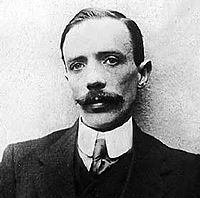Percy Ludgate facts for kids
Quick facts for kids
Percy Edwin Ludgate
|
|
|---|---|

Portrait photograph of Percy Ludgate
|
|
| Born | 2 August 1883 Skibbereen, County Cork, Ireland
|
| Died | 16 October 1922 (aged 39) Dublin, Ireland
|
| Resting place | Mount Jerome Cemetery, Dublin |
| Nationality | Irish |
| Known for | Design of the second analytical engine in history |
| Scientific career | |
| Fields | mechanical computer design & discrete logarithms (1909); Accountancy (1917) |
| Institutions | Kevans & Son (Dublin, Ireland) |
| Influences | Charles Babbage (latterly) |
Percy Edwin Ludgate (born August 2, 1883 – died October 16, 1922) was an Irish scientist and inventor. He designed the second ever analytical engine. This was like an early computer that could do many different tasks.
Contents
Percy Ludgate's Life Story
Percy Ludgate was born in Skibbereen, County Cork, Ireland, on August 2, 1883. His parents were Michael Ludgate and Mary McMahon.
When he was 18, in 1901, he worked for the government in Dublin. He helped with education records. By 1911, he was a clerk for a company that sold grain.
Percy also studied accounting at Rathmines College of Commerce. He was very good at it and won a gold medal in 1917. Later, he worked for an accounting firm called Kevans & Son.
Designing an Early Computer
Percy Ludgate was very interested in calculating machines. He worked on his ideas at night, after his day job as a clerk.
He designed his analytical engine without knowing about Charles Babbage's earlier designs. Babbage was another famous inventor who worked on similar machines. Ludgate's design was the second mechanical analytical engine ever made.
How Ludgate's Engine Was Different
Ludgate's engine was unique in many ways:
- It used multiplication as its main way to calculate, unlike Babbage's, which used addition.
- It had the first multiplier-accumulator. This part could multiply numbers and then add the result.
- It was the first machine to use this multiplier-accumulator to do division. It did this by multiplying with a special number called a reciprocal.
Ludgate's engine also used a system like a slide rule. It used his own special "Logarithmic Indexes," which are now called Irish logarithms.
Storing Information and Control
His design had a very new way to store numbers. It used spinning cylinders and rods that moved. This was a clever way to keep track of information.
The engine also had advanced ways to control its programs. This included features like stopping one task to start another (called preemption). It could also run smaller programs within a main program (called subroutines).
A Lost Design
Ludgate's engine was very different from Babbage's. It was a new type of analytical engine. Sadly, we don't know exactly how it worked. The detailed drawings and descriptions he mentioned in 1914 have never been found.
Percy Ludgate worked on his inventions alone, outside of a lab. He often worked late into the night. He is sometimes called an accountant, but he designed his engine years before he became one. We don't know much about his personal life, only what he wrote in his scientific papers.
Percy Ludgate died from pneumonia on October 16, 1922. He is buried in Mount Jerome Cemetery in Dublin.
Ludgate's Lasting Impact

Percy Ludgate's work is still remembered today:
- In 1991, Trinity College, Dublin created the Ludgate Prize. This award goes to the best final-year project in computer science.
- In 2016, the Ludgate Hub opened in Skibbereen, where he was born. This center helps new e-businesses grow.
In October 2022, a special plaque was put on Ludgate's home in Drumcondra. It was put there by the National Committee for Commemorative Plaques in Science and Technology.

